Well, it is finally over, after weeks of working around the clock, but what a success!! LAMP and the Lighthouse hosted our first ever archaeological symposium, in partnership with the GTM-NERR. For three days respected scholars, many of them leaders in the field, came to St. Augustine and presented papers on various aspects of shipwreck and underwater prehistoric archaeology. We heard about Portuguese spice trading galleons, trading vessels lost off West Africa, 10,000 year old submerged sites, 4000-foot deep wrecks in the Gulf of Mexico, and everything from 18th century British warships to ancient dugout canoes right here in Florida.

We were delighted at the success of the symposium. It attracted more than thirty archaeologists and a lot of interested members of the public. Some individuals drove from neighboring states to see what it was archaeologists had to say. It was a really great mix of professionals, avocationals, and other folks.
The Symposium took place in the new Educational Center for the GTM-NERR (Guana-Tolomato-Matanzas National Estuarine Research Reserve), seen below:
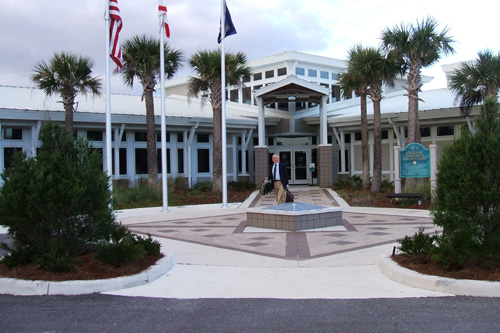
The NERR staff and volunteers were great hosts, and along with the staff and volunteers at LAMP and the Lighthouse, everyone worked hard before and during the event. The quality of the speakers were superb. Below is the Executive Director of the St. Augustine Lighthouse and Museum, Kathy Fleming. Her talk was titled ‘Lighthouses and Maritime Archaeology: Links in a Chain.” She barely pulled it off after her computer crashed, but it turned out great and more than a few folks in the audience came up to me afterwards to comment that they found her presentation truly inspiring!
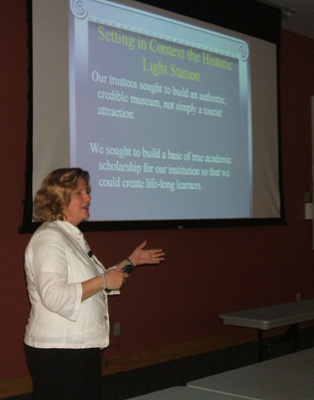
You don’t need a laser pointer if you are as tall as Dr. Michael Faught!
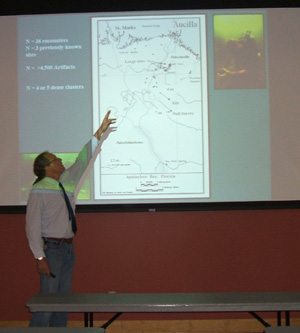
His talk was about the potential for Archaic site archaeology offshore Florida. This period dates to between 8000 and 3000 years ago, after the dramatic climate change heralded by the end of the Ice Age. During the Ice Age dry land extended much further out than today’s coastline, so that human habitation and activity sites have become submerged with rising sea levels after the naturally occuring global warming in the Holocene period.
There were a total of 27 speakers and 29 presentations over three days. Our speakers represented college anthropology and history departments, private non-profit research organizations, cultural resource management firms (private sector archaeologists), museum professionals, federal agencies such as NOAA and the Minerals Management Service, and also a number of graduate students. The complete program, with paper titles and abstracts, can be downloaded as a pdf on the LAMP webpage at
http://www.staugustinelighthouse.com/downloads/lamp_program.pdf
The highlight of the Symposium was the Reception hosted by the St. Augustine Lighthouse.

This was quite a party, with over 200 guests attending. The event was billed as a Celebration of our Maritime Heritage and celebrated not only the Symposium, but two new exhibits: a travelling exhibit of the SS United States, and the opening of a new outside exhibit focusing on the history of the shrimping industry here in St. Augustine. The view from the top of the tower looking down on the event was impressive.
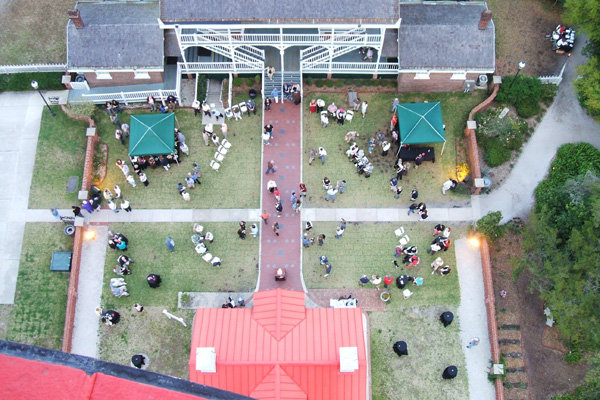
But for me the best moment was when we honored my mentor from my Florida State University days, retired Professor George R. Fischer. George was our keynote speaker, and on Tuesday morning gave a riveting account of the history of underwater archaeology in Florida from the 1950s through today. George is a true pioneer in the field, and his students are now professors in the U.S. and abroad, serve as state, federal, and territorial archaeologists, direct non-profit research organizations, and work in the private sector. He founded and oversaw the underwater archaeology program for the National Park Service in 1972, and was involved with many of the early shipwreck excavations that are now required reading in introductory textbooks (1554 Padre Island galleons, 1733 galleon San Jose, 1622 galleon Rosario, 1748 British warship Fowey, 1865 steamboat Bertrand). George taught, as a volunteer at no cost to the university, for 30 years at FSU, which enabled thier underwater archaeology program and introduced hundreds of students to this exciting and important field. LAMP and the St. Augustine Lighthouse awarded George with the Lifetime Achievement award, for his “many contributions to the field of underwater archaeology, and to the education of this and future generations of underwater archaeologists.” George accepted the award from LAMP Director Chuck Meide (me) along with four other of his former students and his colleague at FSU Dr. Mike Faught. Pictured here left to right are Dr. Della Scott-Ireton (FPAN, University of West Florida), David Ball (Minerals Management Service), George Fischer, and Chuck Meide.
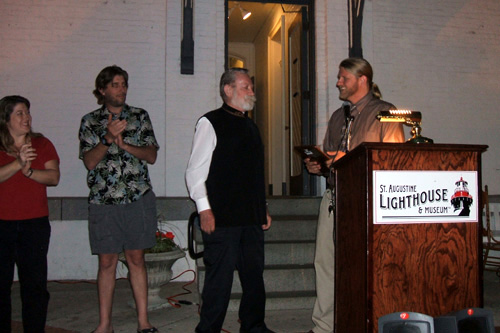
We were all very proud of George Fischer. He truly deserves recognition for a lifetime of achievements and dedication to his students.

We had other great news to announce concerning George. After we had decided to present him with the award, in fact hours after we ordered the commemorative plaque (but days before we surprised him with the award), George offered to donate his personal library to LAMP, to serve as the foundation for our new George R. Fischer Research Library. This is a monumental collection of books, papers, and multi-media resources related to maritime history and underwater archaeology, and is especially impressive because many of its resources are very rare early works that are no longer in print or easily accessible. At the Symposium George presented us with some original footage of the underwater excavation of the 1554 Padre Island wrecks in Texas, including the galleon San Esteban. More is to come later, and our archivists will be busy for years cataloging everything, which is currently in storage in a 30′ long pod in Tallahassee. We are excited about this kick-start to our new library, and even more pleased to have the chance to honor George in a way that he truly deserves.
The Symposium was sponsored by LAMP and the St. Augustine Lighthouse & Museum and also the GTM-NERR. In addition, I’d like to thank our other supporters: the Florida Public Archaeology Network (FPAN), NOAA, the Florida Division of Historical Resources, St. Johns County, the Friends of the GTM Reserve, and the avocational archaeological group St. Augustine Archaeological Association (SAAA).

